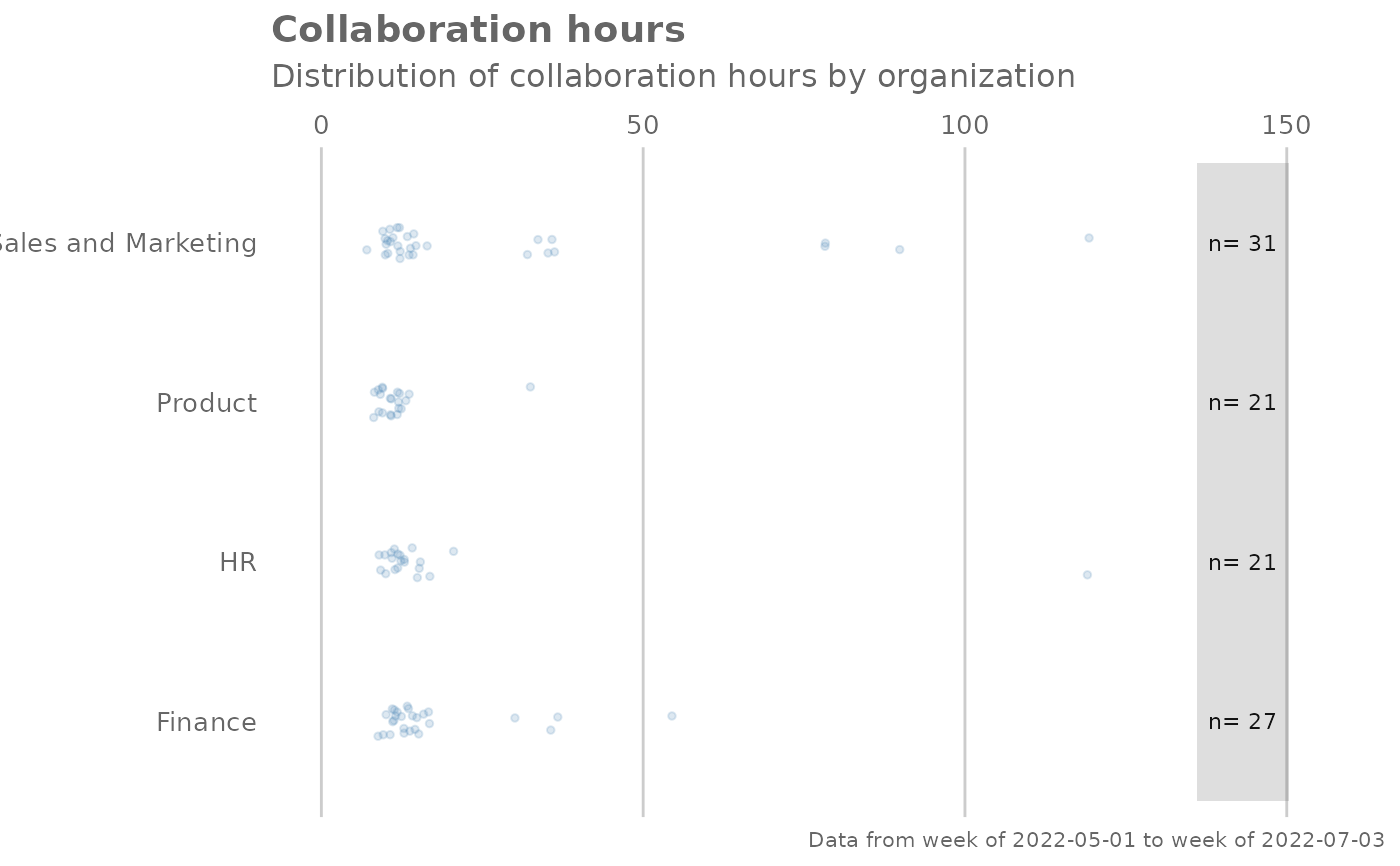
Distribution of Collaboration Hours (Fizzy Drink plot)
Source:R/collaboration_fizz.R
collaboration_fizz.RdAnalyze weekly collaboration hours distribution, and returns a 'fizzy' scatter plot by default. Additional options available to return a table with distribution elements.
Usage
collaboration_fizz(data, hrvar = "Organization", mingroup = 5, return = "plot")
collab_fizz(data, hrvar = "Organization", mingroup = 5, return = "plot")Arguments
- data
A Standard Person Query dataset in the form of a data frame.
- hrvar
String containing the name of the HR Variable by which to split metrics. Defaults to
"Organization". To run the analysis on the total instead of splitting by an HR attribute, supplyNULL(without quotes).- mingroup
Numeric value setting the privacy threshold / minimum group size. Defaults to 5.
- return
String specifying what to return. This must be one of the following strings:
"plot""table"
See
Valuefor more information.
Value
A different output is returned depending on the value passed to the return argument:
"plot": 'ggplot' object. A jittered scatter plot for the metric."table": data frame. A summary table for the metric.
Metrics used
The metric Collaboration_hours is used in the calculations. Please ensure
that your query contains a metric with the exact same name.
See also
Other Visualization:
afterhours_dist(),
afterhours_fizz(),
afterhours_line(),
afterhours_rank(),
afterhours_summary(),
afterhours_trend(),
collaboration_area(),
collaboration_dist(),
collaboration_line(),
collaboration_rank(),
collaboration_sum(),
collaboration_trend(),
create_bar(),
create_bar_asis(),
create_boxplot(),
create_bubble(),
create_dist(),
create_fizz(),
create_inc(),
create_line(),
create_line_asis(),
create_period_scatter(),
create_rank(),
create_rogers(),
create_sankey(),
create_scatter(),
create_stacked(),
create_tracking(),
create_trend(),
email_dist(),
email_fizz(),
email_line(),
email_rank(),
email_summary(),
email_trend(),
external_dist(),
external_fizz(),
external_line(),
external_rank(),
external_sum(),
hr_trend(),
hrvar_count(),
hrvar_trend(),
keymetrics_scan(),
meeting_dist(),
meeting_fizz(),
meeting_line(),
meeting_rank(),
meeting_summary(),
meeting_trend(),
one2one_dist(),
one2one_fizz(),
one2one_freq(),
one2one_line(),
one2one_rank(),
one2one_sum(),
one2one_trend()
Other Collaboration:
collaboration_area(),
collaboration_dist(),
collaboration_line(),
collaboration_rank(),
collaboration_sum(),
collaboration_trend()
Examples
# Return plot
collaboration_fizz(pq_data, hrvar = "Organization", return = "plot")
 # Return summary table
collaboration_fizz(pq_data, hrvar = "Organization", return = "table")
#> # A tibble: 7 × 8
#> group mean median sd min max range n
#> <chr> <dbl> <dbl> <dbl> <dbl> <dbl> <dbl> <int>
#> 1 Finance 23.1 23.1 1.24 20.3 25.4 5.10 68
#> 2 HR 23.1 22.9 1.01 21.0 24.8 3.78 33
#> 3 IT 22.8 22.8 1.43 20.3 26.9 6.65 68
#> 4 Legal 22.5 22.6 1.23 19.7 24.8 5.06 44
#> 5 Operations 23.5 23.3 1.62 20.0 26.4 6.39 22
#> 6 Research 23.3 23.3 1.30 20.1 25.5 5.39 52
#> 7 Sales 23.1 23.2 1.13 21.2 24.7 3.48 13
# Return summary table
collaboration_fizz(pq_data, hrvar = "Organization", return = "table")
#> # A tibble: 7 × 8
#> group mean median sd min max range n
#> <chr> <dbl> <dbl> <dbl> <dbl> <dbl> <dbl> <int>
#> 1 Finance 23.1 23.1 1.24 20.3 25.4 5.10 68
#> 2 HR 23.1 22.9 1.01 21.0 24.8 3.78 33
#> 3 IT 22.8 22.8 1.43 20.3 26.9 6.65 68
#> 4 Legal 22.5 22.6 1.23 19.7 24.8 5.06 44
#> 5 Operations 23.5 23.3 1.62 20.0 26.4 6.39 22
#> 6 Research 23.3 23.3 1.30 20.1 25.5 5.39 52
#> 7 Sales 23.1 23.2 1.13 21.2 24.7 3.48 13